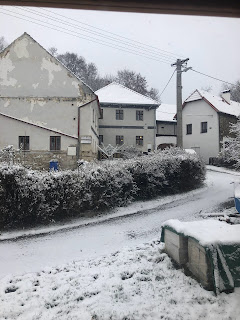 |
| Saving seeds from Aztek tomatoes |
I grow at least 30 tomato plants every year and like to grow unusual heritage varieties. I have found Czech tomato varieties to be particularly good for growing outdoors in my British garden. I think this is because unlike varieties from southern Europe, the Czech varieties are used to having a short growing season and cooler weather.
A particular Czech speciality is 'balkonovy' tomatoes - tomatoes designed to be grown in pots on the balconies of Czech flats. In fact two of my favourites can even be grown on a window sill. These are Aztek (a lovely yellow cherry tomato, see photo) and Vilma (a red tomato). They are described as dwarf or micro-dwarf tomatoes - they grow to about a foot tall (30 cms). Despite their limited height they are remarkably productive and the fruit is really tasty.
I brought the seeds back from the Czech Republic before Brexit restrictions hit and I have been saving seeds from my plants ever since. As always I have more seeds than I need each year and so I share them with two seedsaving groups I belong to. They have proved very popular. Their small size means that you can grow them anywhere sunny where there's room for a pot and they work really well at the front of flowerbeds.
Aztek and Vilma seeds are now available online in the UK from She Grows Veg, they're not cheap but of course once bought you can save seeds for future years, as I do, as both are heritage varieties.
If you are interested in a normal height Czech tomato - try Stupice (Stupicke Polni Rane) which is available from a number of online sellers. It is early to crop, goes on until the last frost, and is very tasty.



















